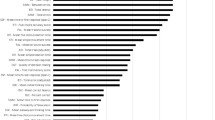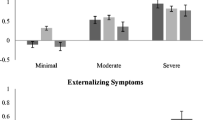Abstract
The present study investigated the self-reported prevalence of attention-deficit hyperactivity disorder (ADHD)symptoms in 770 college students using the Adult Rating Scale and the Wender Utah Rating Scale. Psychometric properties of these scales were explored. The study also investigated the performance of students with ADHD symptoms, relative to students without ADHD symptoms, on a battery of neuropsychological tasks. Results revealed that 7 and 8% of the students reported significant symptoms (i.e., 1.5 SD above the mean) on the Adult Rating Scale and the Wender Utah Rating scale, respectively, and 2.5% reported significant symptoms on both the Adult Rating Scale and the Wender Utah Rating Scale. Using more stringent criteria (two standard deviations), fewer (i.e, 4, 3.8%, and 0.5%) subjects reported significant symptoms associated with ADHD. Between-group differences were found on one of the neuropsychological tasks. The construct validity of the rating scales was supported. Limitations and implications for future research are advanced.
Similar content being viewed by others
References
American Psychological Association (1987).Diagnostic and statistical manual of mental disorders (3rd ed. rev.). Washington, DC: APA.
American Psychological Association (1993). Ethical principles of psychologists and code of conduct.American Psychologist, 47, 1597–1628.
Barkley, R. A. (1990).Attention deficit hyperactivity disorder: A handbook for diagnosis and treatment. New York: Guilford Press.
Barkley, R. A., Fischer, M., Edelbrok, C. S., & Smallish, L. (1990). The adolescent outcome of hyperactive children diagnosed by research criteria: I. An 8-year prospective follow-up study.Journal of the American Academy of Child and Adolescent Psychiatry, 29, 546–557.
Barkley, R. A., Grodzinsky, G., & DuPaul, G. J. (1990). Frontal lobe functions in attention deficit disorder with and without hyperactivity: A review and research report.Journal of Abnormal Child Psychology, 20, 163–188.
Boucagnani, L. L., & Jones, R. W. (1989). Behaviors analogous to frontal lobe dysfunction in children with attention deficit hyperactivity disorder.Archives of Clinical Neuropsychology, 4, 161–173.
Buchsbaum, M. S., Haier, R. J., Sostek, A. J., Weingarner, H., Zahn, T. P., Siever, L. J., Murphy, D. L., & Brody, L. (1985). Attention dysfunction and psychopathology in college men.Archives of General Psychiatry, 42, 354–360.
Carlson, C. L., Lahey, B. G., & Neeper, R. (1986). Direct assessment of the cognitive correlates of attention deficits disorders with and without hyperactivity.Journal of Behavioral Assessment and Psychopathology, 8, 69–86.
Chelune, G. J., Ferguson, W., Koon, R., & Dickey, T. O. (1986). Frontal lobe disinhibition in attention deficit disorder.Child Psychiatry and Human Development, 16, 221–234.
Cohen, N. J., Weiss, G., & Minde, K. (1972). Cognitive styles in adolescents previously diagnosed as hyperactive.Journal of Child Psychology and Psychiatry, 13, 203–209.
Deragotis, J. P. (1992).The Brief Symptom Inventory. New York: Clinical Psychometric Research.
DuPaul, G. (1995). The ADHD Rating Scale: Normative data, reliability, and validity (in press).
Fischer, M., Barkley, R., Fletcher, K., & Smallish, L. (1993). The stability of dimensions of behavior in ADHD and normal children over an 8-year follow-up.Journal of Abnormal Child Psychology, 21, 315–337.
Gorenstein, E. E., Mammanto, C. A., & Sandy, J. M. (1989). Performance of inattentive-over-active children on selected measures of prefrontal type function.Journal of Clinical Psychology, 45, 619–632.
Grant, D., & Berg, E. (1981).Wisconsin card sorting test. Los Angeles: Western Psychological Services.
Klein, R., & Mannuzza, S. (1991). Long term outcome of hyperactive children: A review.Journal of the American Academy of Child and Adolescent Psychiatry, 30, 383–387.
Lezak, M. (1983).Neuropsychological assessment, 2nd ed. New York: Oxford Press.
Loge D. V., Statton, R. D., & Beatty, W. W. (1990). Performance of children with ADHD on tests sensitive to frontal lobe dysfunction.Journal of the American Academy of Child and Adolescent Psychiatry, 29, 540–545.
Luria, A. R. (1966).Higher cortical functions in man. New York: Basic Books.
Mannuzza, S., Klein, R. G., Malloy, P., Giampino, T. L., & Addalli, K. A. (1991). Hyperactive boys almost grown up. V. Replication of psychiatric status.Archives of General Psychiatry, 48, 77–83.
Mannuzza, S., Klein, R., Bessler, A., Malloy, P., & LaPadula, M. (1993). Adult outcome of hyperactive boys: Educational achievement, occupational rank, and psychiatric status.Archives of General Psychiatry, 50, 565–576.
Munoz-Millan, R., & Casteel, C. (1989). Attention deficit hyperactivity disorder: Recent literature.Hospital and Community Psychiatry, 40, 699–707.
Parry, P. (1973).The effects of reward on the performance of hyperactive children, Unpublished doctoral dissertation. Montreal: McGill University.
Raven, J. (1965).Guide to using the coloured progressive matrices. New York: Psychological Corp.
Shaw, G., & Giambra, L. (1993). Task unrelated thoughts of college students diagnosed as hyperactive in childhood.Developmental Neuropsychology, 9, 17–30.
Shue, K., & Douglas, V. (1989). Attention deficit hyperactivity disorder, normal development and the frontal lobe syndrome.Canadian Psychology, 30, 498.
Trennery, M., Crosson, B., DeBoe, J., & Leber, W. R. (1987).The Stroop neuropsychological screening test. FL: PAR, Inc.
Trennery, M., Crosson, B., DeBoe, J., & Leber, W. R. (1998).The visual search and attention test. FL: PAR, Inc.
Ward, M., Wender, P., & Reimherr, F. (1993). The Wender Utah Rating Scale: An aid in retrospective diagnosis of children with ADHD.American Journal of Psychiatry, 160, 245–256.
Weiss, G., & Hechtman, L. T. (1986).Hyperactive children grown up. New York: Guilford Press.
Weiss, G., Hechtman, L. T., & Perlman, L. C. (1978). Hyperactives as young adults: School, employer, and self rating scales obtained during ten year follow-up evaluation.American Journal of Orthopsychiatry, 48, 438–445.
Weyandt, L. L., & Willis, G. (1994). Executive functions in school-age children: Potential efficacy in tasks in discriminating clinical groups.Developmental Neuropsychology, 10, 27–38.
Zentall, S. S., & Dwyer, A. M. (1989). Color effects on the impulsivity and activity of hyperactive children.The Journal of School Psychology, 27, 165–173.
Author information
Authors and Affiliations
Rights and permissions
About this article
Cite this article
Weyandt, L.L., Linterman, I. & Rice, J.A. Reported prevalence of attentional difficulties in a general sample of college students. J Psychopathol Behav Assess 17, 293–304 (1995). https://doi.org/10.1007/BF02229304
Accepted:
Issue Date:
DOI: https://doi.org/10.1007/BF02229304




